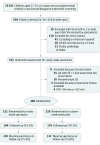Predictors of Spectacle Wear and Reasons for Nonwear in Students Randomized to Ready-made or Custom-made Spectacles: Results of Secondary Objectives From a Randomized Noninferiority Trial
- PMID: 30703197
- PMCID: PMC6459098
- DOI: 10.1001/jamaophthalmol.2018.6906
Predictors of Spectacle Wear and Reasons for Nonwear in Students Randomized to Ready-made or Custom-made Spectacles: Results of Secondary Objectives From a Randomized Noninferiority Trial
Abstract
Importance: Visual impairment from uncorrected refractive errors affects 12.8 million children globally. Spectacle correction is simple and cost-effective; however, low adherence to spectacle wear, which can occur in all income settings, limits visual potential.
Objective: To investigate predictors of spectacle wear and reasons for nonwear in students randomized to ready-made or custom-made spectacles.
Design, setting, and participants: In planned secondary objectives of a noninferiority randomized clinical trial, students aged 11 to 15 years who fulfilled eligibility criteria, which included improvement in vision with correction by at least 2 lines in the better eye, were recruited from government schools in Bangalore, India. Recruitment took place between January 12 and July 15, 2015, and analysis for the primary outcome occurred in August 2016. Data analysis for the secondary outcome was conducted in August 2018. Spectacle wear was assessed by masked observers at unannounced visits to schools 3 to 4 months after spectacles were distributed. Students not wearing their spectacles were asked an open-ended question to elicit reasons for nonwear.
Main outcomes and measures: Predictors of spectacle wear and reasons for nonwear.
Results: Of 460 students recruited and randomized (52.2% male; 46 students aged 11 to 12 years and 13 to 15 years in each trial arm), 78.7% (362 of 460) were traced at follow-up, and 25.4% (92 of 362) were not wearing their spectacles (no difference between trial arms). Poorer presenting visual acuity (VA) and improvement in VA with correction predicted spectacle wear. Students initially seen with an uncorrected VA less than 6/18 in the better eye were almost 3 times more likely to be wearing their spectacles than those with less than 6/9 to 6/12 (adjusted odds ratio, 2.84; 95% CI, 1.52-5.27). Improvement of VA with correction of 3 to 6 lines or more than 6 lines had adjusted odds ratios of 2.31 (95% CI, 1.19-4.50) and 2.57 (95% CI, 1.32-5.01), respectively, compared with an improvement of less than 3 lines. The main reason students gave for nonwear was teasing or bullying by peers (48.9% [45 of 92]). Girls reported parental disapproval as a reason more frequently than boys (difference, 7.2%).
Conclusions and relevance: Three-quarters of students receiving spectacles were wearing them at follow-up, which supports the use of the prescribing guidelines applied in this trial. Predictors of spectacle wear, poorer presenting VA, and greater improvement in VA with correction are similar to other studies. Interventions to reduce teasing and bullying are required, and health education of parents is particularly needed for girls in this setting.
Trial registration: isrctn.org Identifier: ISRCTN14715120.
Conflict of interest statement
Figures
Comment in
-
Establishing Prescribing Guidelines in School-Based Eye Health Programs in Children Aged 11 to 15 Years-The Conundrum of Cost vs Benefit.JAMA Ophthalmol. 2019 Apr 1;137(4):415-416. doi: 10.1001/jamaophthalmol.2018.6900. JAMA Ophthalmol. 2019. PMID: 30703194 No abstract available.
References
Publication types
MeSH terms
LinkOut - more resources
Full Text Sources
Medical


